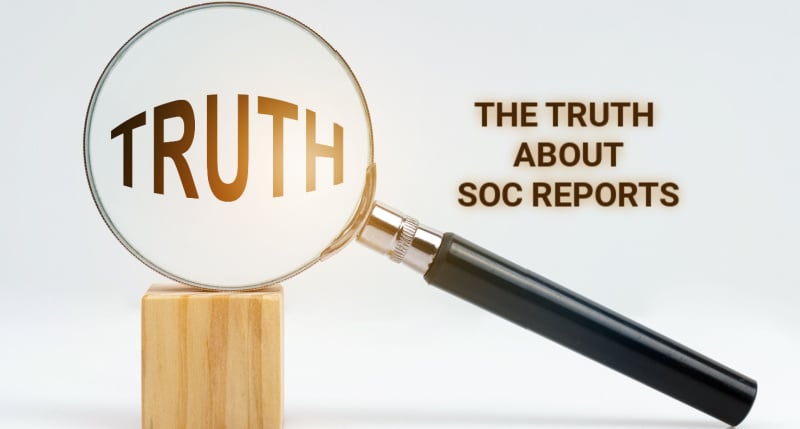Has a client ever asked you if an SAAS application is secure? If you said yes based on the AICPA badge displayed on their website without reading the report, you may have given less-than-accurate information.
As accounting professionals, most of us are aware of SOC (Service Organization Control) reporting and understand its importance in safeguarding our clients' privacy and data, but do you really know what it means when a company claims to be SOC compliant and how to apply the reports to real-world situations?
There are five variations of SOC reports, and it’s important for us, as our client’s strategic and trusted advisors, to understand, explain, and apply this tool. In this article, we break down what each SOC report means, how it relates to client needs, and other steps you should be taking to mitigate risk.
Types of SOC Reports
There are three main types of SOC reports:
SOC 1 – Financial Reporting Focus: This report focuses on internal control over financial reporting. These controls are critical for service organizations that process or handle financial data, such as general ledger platforms, payment processors, or payroll providers.
SOC 2 – Operational and Compliance Controls: Concentrates on controls relevant to security, availability, processing integrity, confidentiality, or privacy. This report is essential for service organizations that manage or store client data, offering assurance on information security and privacy practices.
SOC 2 could apply to virtually any SAAS company since almost all store some client data. However, particular scrutiny should be placed on companies that store or manage sensitive client data, like personal or financial information.
SOC 3: Similar in content to SOC 2, but designed for a general audience, SOC 3 reports provide a high-level overview of a service organization’s controls without the detailed disclosures in SOC 2 reports.
Type 1 vs. Type 2 Reports
SOC reports are further divided into Type 1 and Type 2 reports.
- Type 1 Reports assess the suitability of the design of controls at a specific point in time.
- Type 2 Reports evaluate the operational effectiveness of these controls over a period, usually a minimum of six months.
Each report serves a distinct purpose and is tailored to different audience needs. Understanding each report's specific focus and audience is crucial for accounting professionals to make informed decisions and recommendations.
The existence of a SOC report is NOT a guarantee
Service Organization Control (SOC) reports provide varying levels of detail on a service organization’s controls. While each report type has its unique focus, all require careful reading and interpretation.
A common misconception is that the presence of a SOC icon on a service provider’s website indicates compliance, but it does not inherently guarantee current compliance or the effectiveness of the controls. This is especially true of companies that only have a SOC1 report and claim to be SOC-compliant. Remember that a SOC1 report is only related to financial controls, not data security, and the existence of a report is never a “certification.”
It's important to read the report and dig deeper
This situation mirrors financial auditing, where an auditor’s report identifies risks and offers assurance but does not eliminate all risks or guarantee the absolute accuracy of financial statements. Similarly, in using SOC2 reports, user entities must conduct their own risk assessments and verify that the service organization's controls align with their specific needs and standards. In short, the existence of a SOC report does not “certify” or “ensure” compliance, it only states that a report exists.
The SOC2 report, produced by a service auditor, objectively evaluates the service organization’s controls over security, availability, processing integrity, confidentiality, or privacy. However, this report does not shift the responsibility for the outsourced functions from the user entity to the service organization. For more information on utilizing SOC2 reports and understanding their implications, the AICPA provides valuable resources and guidance, which can be accessed here.
Beyond SOC Reports: Comprehensive Security Assessment
While understanding and interpreting SOC reports is one aspect of assessing a service organization's control environment, it's just the starting point in a comprehensive security and privacy assessment. As we’ve learned, informative as they are, SOC reports may not cover every aspect of security necessary for a holistic risk evaluation. As trusted advisors, it's imperative to adopt additional measures to thoroughly assess a service partner's security posture. Let’s explore some practical steps and strategies beyond SOC reports to ensure a more robust evaluation of your service partners' security and privacy controls.
Practical steps for assessing security and privacy
Assessing a company's security and privacy goes beyond simply reviewing SOC reports. While informative, these reports may not cover all relevant security controls necessary for a comprehensive risk assessment. To truly gauge a company's security and privacy posture, several additional strategies and measures should be considered.
- 1. Reviewing Additional Documentation: In addition to SOC reports, it's beneficial to examine other documentation, such as the company's security policies, procedures, and standards. This includes understanding their incident response and disaster recovery plans, application development controls, and data privacy measures.
- 2. Customized Security Questionnaires: Creating and utilizing customized security questionnaires for vendors can help target specific security controls or areas not adequately covered in SOC reports. This approach allows for a more tailored assessment of a vendor's security posture. Smartsheet has a free vendor risk assessment template you can start with.
- 3. Assessing Subservice Organizations: In cases where vendors rely on subservice organizations, it's important to consider these entities' security controls. Reviewing the SOC reports of these subservice organizations, or other relevant security documentation, can provide a fuller picture of the security landscape.
- 4. Regular Monitoring and Oversight: Continuous monitoring and oversight of a vendor's security practices are crucial. This should include regular updates and reassessments to ensure security measures remain effective and aligned with changing requirements and threats.
- 5. Risk Management Focus: Lastly, it is key to focus on risk management and understand how a vendor's security controls align with you and your client’s risk profile and compliance requirements. This involves thoroughly assessing how the vendor's security practices integrate with your organization's security strategy.
Engaging experts can help mitigate risk
Engaging security professionals provides the expertise necessary to comprehensively assess and address the intricate challenges of cybersecurity and data privacy, a vital consideration for firms of all sizes in today's digital landscape. Several companies, like thirdpartytrust, PracticeProtect, and Visory, provide managed security solutions.
While SOC reports provide valuable insights into a service organization’s control environment, they represent just one piece of the puzzle in the broader security and privacy assessment context. Particularly for small firms, deciphering the full spectrum of cybersecurity and data privacy risks without specialized knowledge can be challenging. Engaging with security experts is not just a recommended step; it often becomes a necessity. These professionals bring a depth of understanding and experience crucial for comprehensively and effectively evaluating security measures.
.png?width=150&height=63&name=TWRlogo-regmark_blueblack%20(1).png)
.png)










Do you have questions about this article? Email us and let us know > info@woodard.com
Comments: